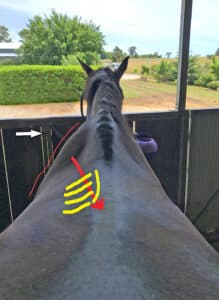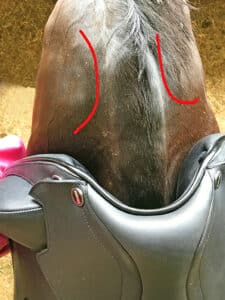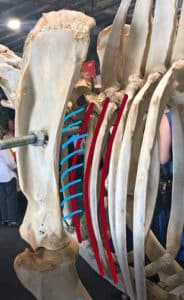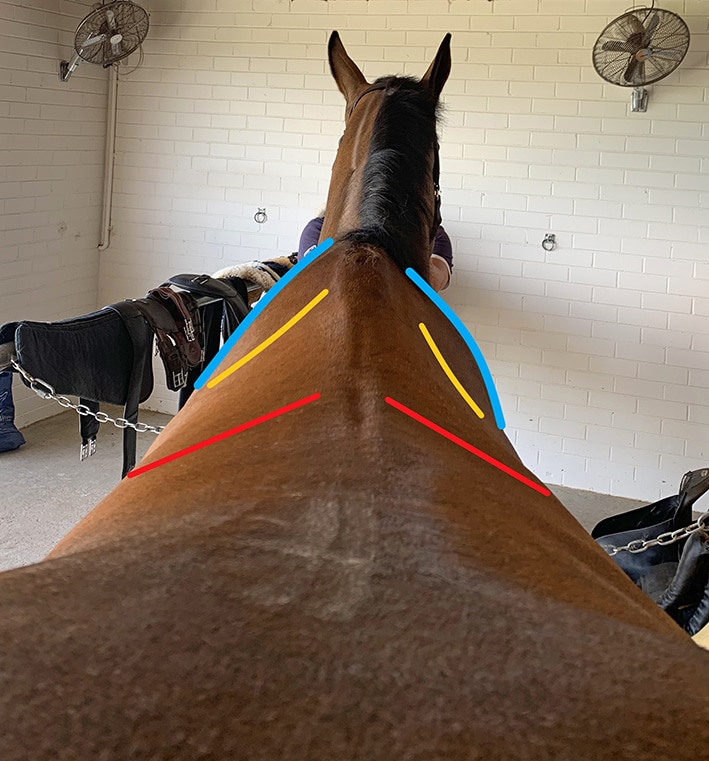No horse is perfectly symmetrical, which can create issues when it comes to the fit of your saddle. Saddle fitting expert PAULA JEFFERY discusses asymmetry and its affects.
Do any of the following sound familiar to you?
‘I can’t seem to put weight in my right stirrup and it always feels too long’
‘My instructor keeps telling me I collapse to the left and I’ve got to sit straighter’
‘Every time I canter to the right I feel like I’m falling off to the left’
‘My saddle is constantly slipping left no matter how many times I straighten it or tighten the girth!’
‘My horse is really reluctant to bend to the right and gets hard in my hand and grumpy, but is happy to bend left and is softer.’
All of these issues can be caused by the effect of a horse’s asymmetry – from either the shoulders, hindquarters, feet or back muscles – on your saddle. No horse, or rider for that matter, is perfectly symmetrical. Which makes placing a symmetrical object (a saddle) between the two, all the while hoping it will move straight and distribute the pressure from the rider’s weight evenly on the horse’s back muscles, a bit of a challenge!
However, when we have major asymmetry in the horse’s musculature, posture or biomechanics (how he moves), we will start to see some of the problems mentioned above.

How asymmetric shoulders influence saddle and rider
A horse does not have any bony connection between their scapula and their ribs or spine. Instead, the horse’s massive and heavy torso is slung between the two front limbs, supported by a series of muscles, tendons and ligaments called the thoracic sling. That means we can have very different muscle build up on one side of the sling to the other, increasing the space between the scapula and the ribs on one side. This can create a ‘bulgy’ or bigger shoulder.

More than that, if the horse’s feet are not symmetrical with one heel higher than the other, or a club foot, or a narrow more upright foot, it has a direct influence on the height of the scapula and sometimes the angle of the scapula – so we can have one shoulder higher or more rearward than the other.
How does this affect the saddle?
The shoulder blades have to rotate under the front of the saddle with every single stride. So as each one slides under the front of the saddle it has a slight lateral (or sideways) swing at the cantle: left, right, left, right and so on. You can see this if you stand behind the saddled horse as it moves in a straight line away from you in walk and trot.

If one shoulder is bigger or more rearward than the other, it is going to have more ‘push’ on the front of the saddle than the other. If it’s the left one for instance, when viewed from behind you will see the cantle swing significantly over to the right, away from the push of the big left shoulder, and only move slightly (if at all) back to the left when the smaller right shoulder slides under the saddle.
This means that the left panel under the cantle moves more towards the spine, and puts constant pressure on the left hand edge of the spine. Consequently, the horse is going to want to move away from the uncomfortable pressure and pain, and will more likely bend to the left, or swing his hindquarters away to the right, so he is no longer straight in his body or neck, nor is he travelling straight.
How does this affect the rider?
As the saddle slips and twists off to the right, the rider is going to collapse and likely twist their shoulders to the left. They may ‘give away’ their right rein and get sore on one side of their lower back. Their seat may slide over to the right as they no longer have support from the saddle under their right seat bone. This is exacerbated in left canter and it feels impossible to keep even weight in both stirrups – and with the rider’s weight becoming uneven in the saddle, it makes the saddle slip worse.

It’s likely that in this position their right leg will go forward and away from the horse, and their left leg will come back and grip more – unfortunately all of these unconsciously increased rider pressures from an unbalanced rider actually tell the horse to keep bending left!
Just imagine how confusing it can be to the horse when you then try and straighten him by pulling more on the right rein. No wonder they become resistant with such conflicting pressures!
What can we do?
If you are recognising any of these symptoms, it is really important to first identify where the asymmetry is in your horse. The cause could be to do with their conformation, or uneven muscle development, a previous injury, or even undiagnosed problems that need investigation.
We can often address and improve the degree of asymmetry by involving other equine professionals, our ‘Circle of Care’, which includes your vet, dentist, farrier, physio or body worker, saddlefitter, and coach. And it often takes a combined
approach from all of them to help improve the horse’s body, comfort and movement. But by doing so, you will make his job easier and you’ll have a happy, healthier partner.
Saddlefitting Solutions
Once you know what you’re dealing with, your saddlefitter can look at offering some solutions. It’s essential that your saddlefitter assesses your horse’s asymmetries statically (standing still) and dynamically (whilst in movement) in all three paces. You’ll need to walk and trot the horse in hand on a straight line for your fitter, both with and without the saddle, so they can assess how much the horse’s asymmetries affect the movement of the saddle. They will also need to evaluate the horse/saddle/rider combination while you’re in the saddle. This will give a clearer picture of the changes that occur with you on board, as well as creating an opportunity to try out some possible solutions.
Visit Paula and her team at www.performancesaddlefits.com.au
Feature Image 1: When muscles on one side of the thoracic sling build up more than on the other, it can create a ‘bulgy’ or bigger shoulder.



